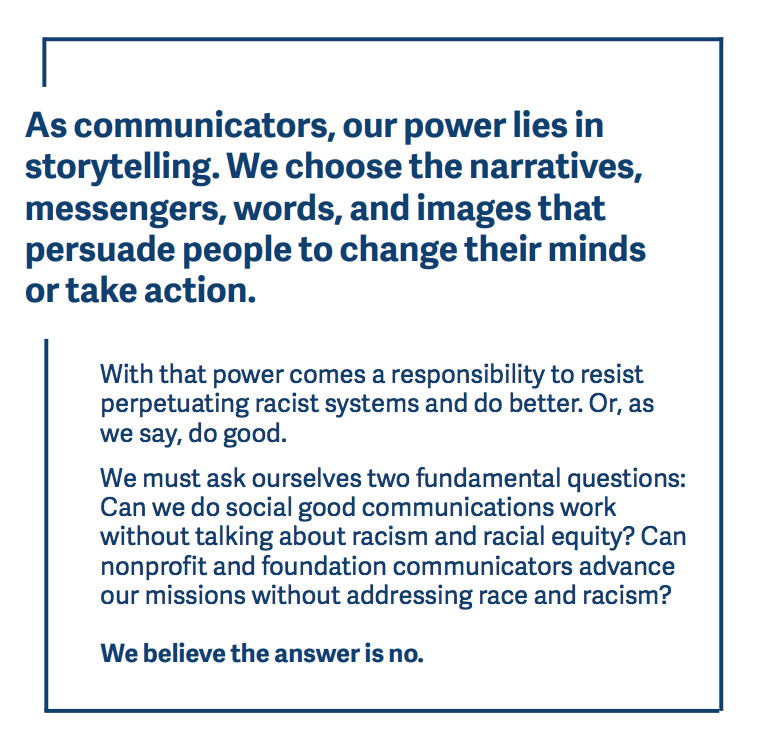Integrate racial equity practices into your brand and communications
How can foundation and nonprofit communicators improve racial equity through their work? The Communications Network recently released a report and series of tools, in partnership with M+R and We-Collab, to change norms and practices in communications for social good.

In 2019, they conducted research and environmental scans, facilitated interviews, implemented a survey, and then surfaced key insights. It’s worth noting that much of this research was conducted before the recent protests and national attention on racial justice that emerged in 2020. Since that time, organizations have deepened their commitments to advancing racial justice but there is still so much work to be done.
The key findings from their report are worth reflecting on:
- Racism is absent from diversity, equity, and inclusion (DEI) plans and commitments. The terms “race” and “racism” rarely appear in organizational DEI definitions, even for organizations focused on justice and equity.
- Nonprofits and foundations have different definitions of DEI and lack a shared understanding of what equity, diversity, and inclusion mean.
- Impact bias is present in social good communications and some people don’t see themselves reflected in messaging.
- There is a significant lack of data and metrics on effective racial equity communications.
- Unlike other communications strategies that can be boiled down to user-friendly message wheels or guidelines, the work of racial equity, diversity, and inclusion is intensely personal. Almost half of the survey respondents recognized unintentional reinforcement of stereotypes and an overall lack of understanding of what language should be used in racial equity messaging.
- To fully embrace racial equity work, organizations need to invest in creating strong internal communications and culture-building across all staff levels.
- There is often a disconnect between the way an organization communicates around racial equity and its internal policies, practices, and staffing.
As a nonprofit communicator, you can integrate efforts to help your organization become antiracist throughout branding, campaigns, and ongoing materials development. On the Communications Network’s microsite, you can access tools and resources related to digital strategy and content, thought leadership, research and data, organizational strategy and management, internal communications, gatherings, outreach via media and messages, and branding and collateral.

With their permission, here is the content from the branding and collateral section. We invite you to actively apply these resources and question how you can advance racial equity in your communications.
External branding is often the first touch an individual has with an organization. The resulting impression is long-lasting, and it's up to the communications team to make it not only a positive interaction but an accurate one. Through a variety of antiracist marketing and image-selection strategies, nonprofits can be better equipped to create collateral that's reflective of the partnership they have with the broader communities they're working with.
We’ve created this seven-step tool with the communicator in mind. It’s flexible, so use it as a checklist, a launching point for a discussion, or even an assessment survey to improve your DEI communications.
STEP 1: Evaluate your organization’s brand with the community in mind.
Do you refer to your nonprofit or foundation as a savior, as a partner, or as a bridge? Use this step to present your organization as a collaborative partner, not a hero.
- Familiarize yourself with Harvard University’s Hauser Center for Nonprofit Organizations Nonprofit Brand IDEA framework: brand integrity, brand democracy, brand ethics, and brand affinity. Think about how you can apply it to building and managing your brand.
- Reflect on how you are branding the work that you do and who you are impacting.
- Take the time to interact on an individual level with a wide array of community members to ensure that your organization’s branding and mission statement is in line with their diverse set of values.
Learn More: The Role of Brand in the Nonprofit Sector
STEP 2: When forming your marketing materials, lean on the community to make sure it accurately portrays your organization’s role.
From imagery to logos, the materials you use to represent your nonprofit brand should show a collaboration, not a one-sided body that acts on behalf or in charge of the community.
- Understand the difference between visual and idea-based community collaboration and physical goods collaboration — both are essential to creating an authentic brand that supports and works alongside the community to inspire change.
- When outsourcing a logo or a flyer, try to use Black and minority artists and creators from within your community to bring your vision to life.
- Consider establishing partnerships with local Black and minority-owned businesses to commission marketing/branding collateral, whether it’s printing pamphlets or creating “swag bags” for your events.
Learn More: How Your Nonprofit Can Partner with Local Businesses
Learn More: Crowdsourced Black Comms Creatives Database
STEP 3: Think about tone when you’re selecting photographs to use alongside your communications.
Are you showcasing the aspirations of the people you serve or are you highlighting their deficits? An image can go a long way in guiding people’s perceptions and opinions.
- Don’t let images take a backseat to the words on the page. You spent weeks and weeks preparing the report — there’s thoughtful language, you’ve vetted everything, it reads great. Now, all you need to do is slap on some images and you’re good to go, right? Wrong. The image selection process should happen alongside the writing process — it’s essential for all components of your communications to be vetted.
- Use ethical approaches to photography. Find or commission actual images of community partners. This requires an extra step — approval to use the picture from both the image-taker and the subject — but it’s worth it. Give credit and compensation to the photographer.
- Avoid perpetuating stereotypes through images. Biases and perceptions are influenced by the images and the associated text. Be aware of who you are presenting as the “default,” “good,” or “normal.” For example, if you have text about an “All American” event, consider associating that with an image of patriotic people that are of color. If you have text about the implications of poverty, consider the diversity of communities who find themselves in poverty.
Learn More: Is Image Diversity Affecting Your Nonprofit Branding?
STEP 4: Make your branding explicitly antiracist.
It’s not enough to say your brand is about helping “all people.” An organization that prides itself on its diversity, equity, and inclusion is a brand that understands its responsibility to be outspoken about the barriers people of color face.
- Evaluate your current branding. Be transparent about where it falls short of your internal and external commitments to diversity, equity, and inclusion.
- Don’t shy away from being direct in your antiracist messaging. Now is the time to be clear and concise in your values, mission, and directives.
- Incorporate antiracist messaging within multiple levels of your communications branding strategy. Denouncing racism from the get-go is a great first step, but there are a variety of ways in which that message can be repeated within your language, anecdotes, and imagery.
Learn More: Writing with an antiracist lens
STEP 5: Make sure your branding is in service of equity as well.
Your organization has the opportunity to support communities, cities, and vendors that are Black, Latino, American Indian, or other people of color. The branding materials you select are a direct investment in that community.
- Use your marketing to highlight the work of Black, Latino, American Indian, or other people of color.
- Use Black and minority-owned businesses and vendors for things like events (food, beverage, dessert, etc.) and branding materials (reports, pamphlets, logos, etc.).
- If your event is virtual, consider creative ways to highlight your community members.
Learn More: 6 Reasons to Support Black-Owned Businesses
STEP 6: Mix up your mediums.
From print to video to audio, your organization can reach a diverse audience simply by creating branding and collateral for them on their preferred platform.
- Establish a direct line of communication with your community to get a better understanding of what types of media they prefer.
- When reaching out to the community, don’t just create flyers or send emailers — consider doing podcasts, Instagram, Live Q&As, guest newsletters, etc. The more content you can push out into the world, the more eyeballs you’ll get.
- Consider using innovative technology and new social media sites to extend your reach and elevate your platform.
Learn More: Innovative Marketing From Nonprofits Committed To Diversity, Inclusion, And Lifting Black Voices
STEP 7: Reach out in local languages.
If your marketing is only produced in English, you risk missing a big slice of the pie. A multilingual approach is key to establishing equitable communication channels. Connecting with the community and listening to feedback straight from the source is one of the most impactful ways to begin combating racism.
- Make sure staff members within your communications department are fluent in the language of the community.
- All advertising, promotional, and event materials should be accessible. Be sure to offer them in the primary language of the community, both digitally and in print.
- Invest in translation to create a feedback loop with community stakeholders.
Learn More: Language Justice Toolkit
You can access the report, case studies, tools, and more resources at https://comnetworkdei.org/branding.







